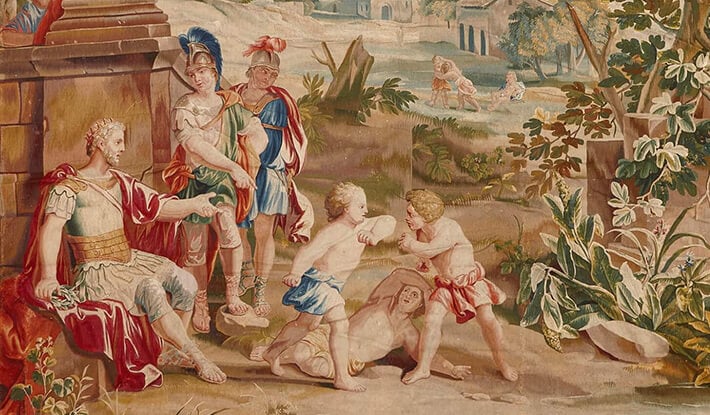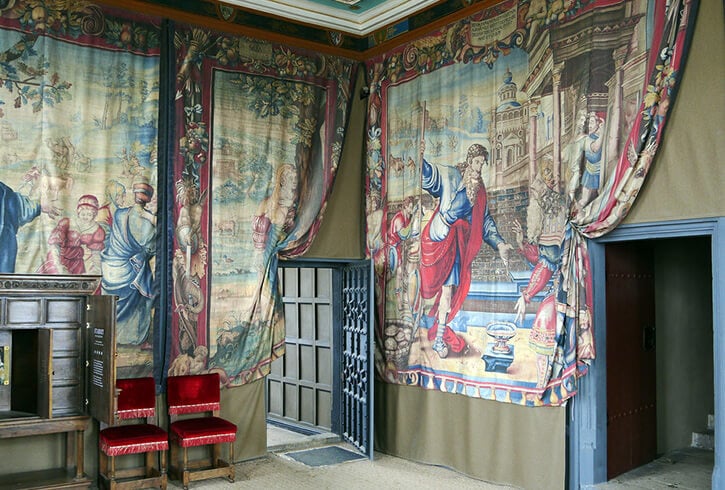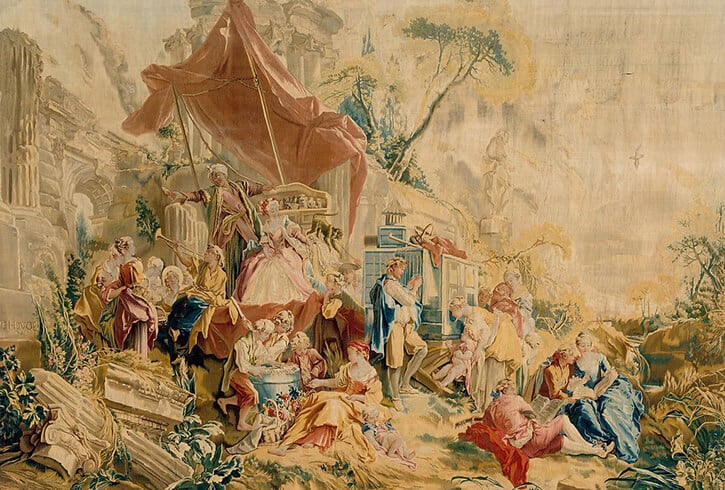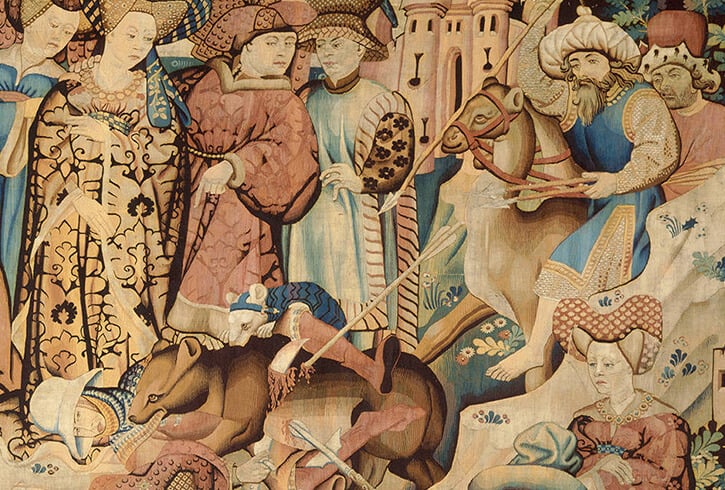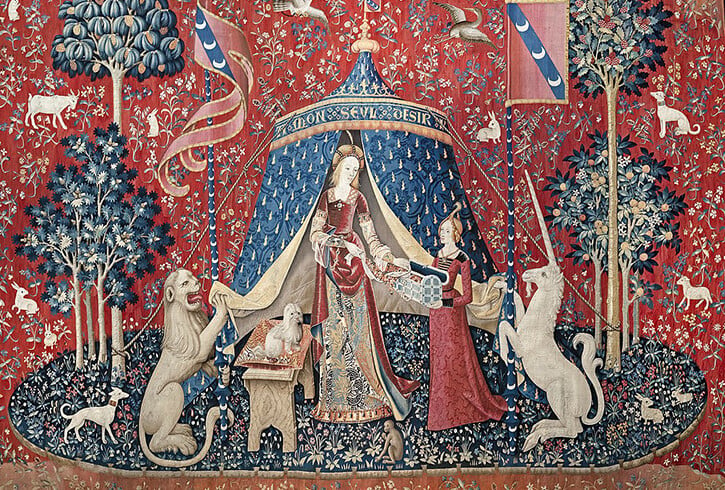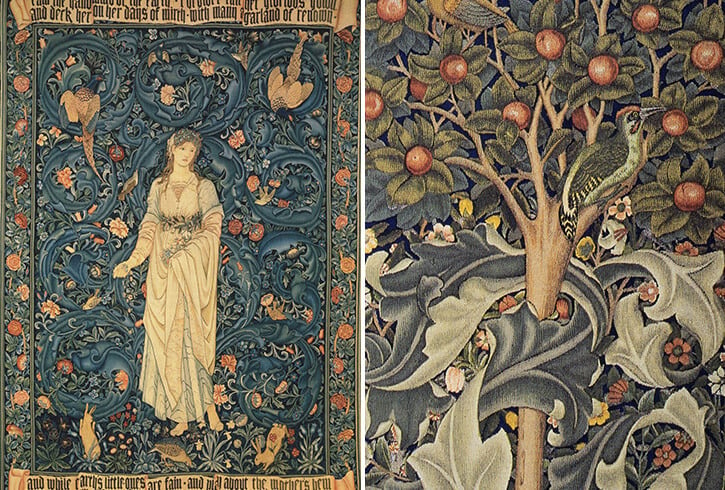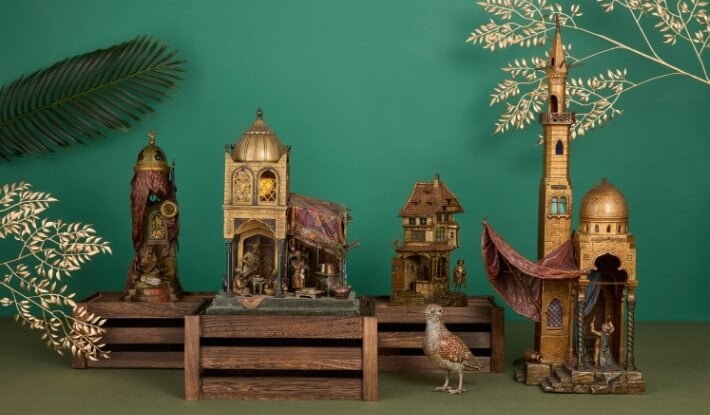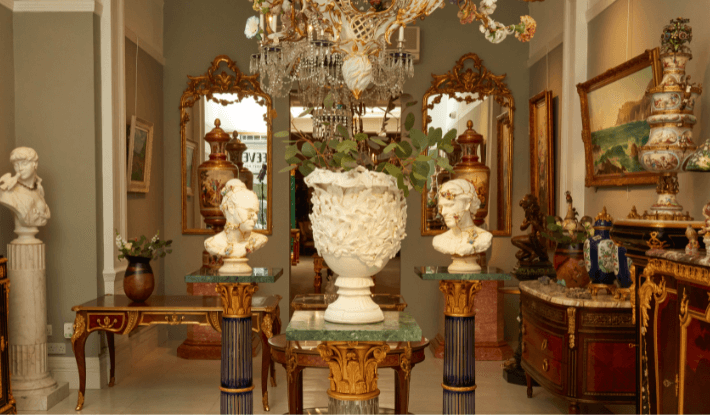Once regarded as the pinnacle of ‘high art’ amongst the European elite, tapestries have literally and figuratively ‘faded’ into obscurity. The mid-14th century to the end of the 18th century was seen as the greatest period of tapestry weaving, during which time thousands of workshops wove incredibly detailed textiles for both private and public spaces.
For royalty and aristocracy, large-scale tapestries had a multitude of functions: works were often commissioned to commemorate significant events such as weddings and coronations, and their narrative designs meant that they could be a great talking point at banquets and parties. And even on a practical level, the use of thickly woven wool meant that they kept out draughts. It is no wonder that Henry VIII is said to have had 2,000 tapestries hanging in his various palaces!
The 10-piece set which adorns the Great Hall of Hampton Court depicts the story of Abraham. Bought by Henry VIII in the early 1540s, the tapestries are the most impressive extant set to survive in Britain.
To look after these large collections, kings and noblemen often had entire buildings of staff to look after their tapestries, known as ‘wardrobe’ departments. Such staff would care for, repair, and even transport the tapestries from one residence to another, allowing these superb artworks to be appreciated internationally.
Read on to learn all about this fascinating craft, tracing the history of the tapestry from its ancient origins to the modern day.
What do we mean by ‘tapestry’?
Tapestry comes under the bracket of ‘textile art’, which is any craft that uses fibres to construct practical or decorative objects, such as sewing, knitting, or weaving. Tapestry itself is a woven textile, distinguished by the fact that the vertical threads (known as ‘warp’ threads) are hidden in the final picture. More colloquially, tapestry has come to signify any large textile wall hanging with a figurative design.
Tapestries at Bolsover Castle, Derbyshire. As tapestries became replaced by paintings as the favoured pictorial art form, the textiles would often be pulled back to make space for doorways or furniture.
The word ‘tapestry’ derives from the Old French ‘tapisserie’, meaning ‘to cover with heavy fabric’, which can be traced back to the ancient Greek ‘tapes’ – meaning ‘carpet, rug’. However, the term ‘tapestry’ was not commonly used until nearly the end of their flourishing period – they were usually just called ‘hangings’ or ‘cloths’!
Process and production
Traditional European tapestries are created by weaving coloured weft (horizontal) threads through plain warp (vertical) threads. The warp threads would have been stretched taught between two rollers, and this ‘loom’ was either placed horizontally (low-warp), or vertically (high-warp). The weft threads could then be woven backwards and forwards across a specific segment to create small blocks of colour – this technique is called ‘discontinuous weft’, as the weft threads do not run all the way across the loom. In time, these blocks of colour would be built up to create a picture.
These two medieval manuscripts illustrate how weavers would operate a low-warp loom - the favoured type in textile workshops at the time.
The weavers would work from a ‘cartoon’, a full-scale painted image which they would essentially ‘trace’. For low-warp looms, strips of the cartoon would be placed beneath the loom, and since tapestries are woven from the back, the final textile would show the design of the original cartoon in reverse. For high-warp tapestries, the cartoon would be hung behind the weaver, who would use a mirror to weave a non-reversed version of the original image. The Raphael Cartoons, which depict the acts of the apostles, are some of the most famous surviving examples of original cartoons from the flourishing period.
This small-scale modern-day low-warp loom allows space for the cartoon itself to be attached to the loom, which the weaver can then view through the warp threads.
Historically, wool was the most widely used material for tapestry weaving, as it was readily available, easy to dye, and naturally strong and flexible. Including silk within the weave could increase the cost of a large tapestry by four times that of wool alone, and adding gold thread could even increase the cost by 50 times! The weavers were usually male, as the work was extremely physically demanding, while it was women who spun the thread. A set of the finest large tapestries could easily take over a year to make, since the higher the quality the finer the threads, and often there would be several weavers working together on a large loom.
Ancient origins
The origins of tapestry as a medium are relatively vague – actual survivals from ancient civilisations are rare. Some of the earliest known fragments were discovered in the late 20th century at Tarim Basin in China. These wool fragments, known as the Sampul tapestry, are thought to date to the Hellenistic period (c. 300 B.C.), and depict a man and a centaur.
The Sampul tapestry was discovered on the border of modern-day China, but its iconography and techniques display a Western influence, suggesting an extent of cross-cultural communication at the time.
The Flourishing Period
From around the mid-14th to the mid-18th century, tapestries were the most sought-after art form with which the European elite could decorate their homes. Extremely large and expensive to produce, tapestries from this period were made in large workshops, concentrated in several cities in the North of France and the South of The Netherlands. Tapestries from this era are often referred to as ‘Flemish Tapestries’, even though most were not produced in the County of Flanders (modern-day Belgium).
The Flourishing period – workshops and patrons
Over this 400-year period, different cities held the title of ‘weaving centre’ - Paris initially led the tapestry field, followed by the French town of Arras. By the 1500s, Brussels was the undoubtable centre of industry. Several particularly notable manufactories emerged however in 17th century France. Established in 1663 by Jean-Baptiste Colbert, The Gobelins manufactory in Paris is best known for supplying the court of King Louis XIV with tapestries and other textiles, run under the superintendence of court painter and chief tapestry designer Charles Le Brun. The prestige of the manufactory was rivalled by the equally established Beauvais Manufactory. A private enterprise also set up by Colbert, the manufactory gained great renown for its tapestries in the 18th century, with cartoons designed by celebrated Rococo painter François Boucher. The 45 ‘Boucher-Beauvais’ tapestries produced during this collaboration, now well known, are often seen as the embodiment of the Rococo style. The Aubusson manufactory, based in central France, was also highly regarded.
This tapestry, entitled ‘The Charlatan and the Peep Show’, was designed by Boucher for Beauvais as part of his ‘Fêtes Italiennes’ series.
The Flourishing Period – subjects and styles
Tapestries of this era were often made in sets, and typically depicted complicated narrative or allegorical scenes. In comparison to contemporary painting trends, the textiles were relatively ‘crowded’ in their design. This was because weaving a ‘plain’ area of sky or grass involved just as much work as weaving figures, so any ‘empty’ space tended to be filled with additional narrative details.
The Triumph of Fame, Netherlandish, probably Brussels, c. 1502–4. Based in part on Petrarch’s poem The Triumphs, this tapestry was part of a set of six representing the consecutive Triumphs of Love.
Two of the most popular subjects for these large-scale sets were hunting or military scenes. For the former, these were usually in an abstract setting, filled with noblemen and women that reflected the elite personage of the owner. Military tapestries, on the other hand, tended to be more personalised, celebrating the wartime victories of the commissioner or rendering the victories of classical heroes like Alexander the Great or Julius Caesar.
A detail from one of the Devonshire Hunting Tapestries (1430-1450), four tapestries that depict fanciful scenes of men and women on a forest-set hunt.
Another intriguing type of tapestry popular during this period was the millefleur, where, as the name suggests, the background of the textile would be filled with a variety of small flowers and plants arranged in no discernible pattern. This unusual style is only found in tapestry, mainly from c. 1480-1520, and unlike hunting or military scenes millefleur tapestries were far less focused on realism or narrative. Animals and figures in the composition would often be very small in relation to the surrounding plants, as well as not being in proportion with each other. Two of the most famous examples in this style are the ‘Unicorn Tapestry’ sets: still debated today, these mysterious large-scale millefleur sets have been read as allegories of the senses and the life of Christ respectively.
The final tapestry in The Lady and the Unicorn tapestries, a set of six textiles in the millefleur style. Whilst the other five tapestries each depict one of the five senses, this final tapestry is intriguingly entitled ‘À mon seul désir’ (’To my sole desire’)
Weaving the history – the Arts and Crafts period
In the 19th century, following around 100 years of decline, tapestries were given a new lease of life by the Arts and Crafts movement, most notably by William Morris. Morris believed tapestry to be “the noblest of the weaving arts’, and taught himself to weave via a 14th century French crafts manual. After setting up a tapestry workshop at Merton Abbey Works (London) in 1881, Morris created a successful series of tapestries for both home and ecclesiastical uses. The textiles combined figures based on cartoons by the artist (and Morris’ great friend) Edward Burne-Jones, with background designs by Morris, heavily inspired by millefleur or verdure (foliate) designs.
These two William Morris tapestries show the influence of the millefleur style on the Arts and Crafts movement.
Outside of Europe
Notable non-European examples of tapestry have been Persian Kilims – flat tapestries with geometric designs that were used as rugs – and Chinese Kesi. Quite unlike these large-scale examples of European tapestry, Kesi tapestries were made on a much smaller scale primarily for clothing, and instead used silk as the primary material. The use of silk, as well as their higher knot density, meant that one well-made gown could take as much work as a large European tapestry!
Part of a large set of panels, this Kesi tapestry depicts a charming birthday celebration.
Tapestries in the modern world
Following the revival of the medium by Morris, tapestry-making continues to grow in the contemporary craft sphere. A key development from the late 20th century onwards has been the centrality of the weaver as an ‘artist’: whereas once a tapestry would pass through a commissioner, patron, cartoonist, and weaver, now often the entire process is completed by one individual. Whilst technological advancements mean that tapestries can now be woven mechanically, many artists choose to continue to work by hand, playing with form and design to continually redefine this historic genre.
Mayfair Gallery is proud to offer a superb collection of antique tapestries, with textiles from all over the world. Explore the full collection here.




